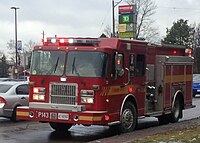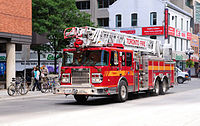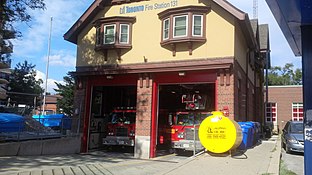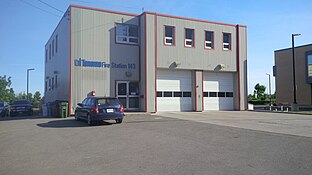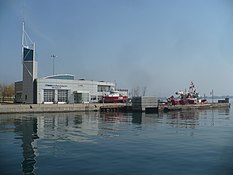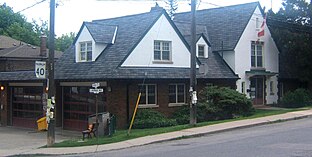Toronto Fire Services

This article has multiple issues. Please help improve it or discuss these issues on the talk page. (Learn how and when to remove these messages)
|
 | |
| Agency overview | |
|---|---|
| Established | 1874 (as Toronto Fire Department), 1998 (as Toronto Fire Services) |
| Annual calls | 469,056 (2023)[1] |
| Employees | 3,258 (2023)[1] |
| Annual budget | C$524.440 million (2019) |
| Staffing | Career |
| Fire chief | Matthew Pegg[2] |
| EMS level | First Responder |
| Motto | "Courage, Compassion, Service" |
| Facilities and equipment | |
| Stations | 84 |
| Engines | 86 |
| Trucks | 6 |
| Quints | 26 |
| Squads | 5 |
| Tenders | 2 |
| HAZMAT | 4 |
| Fireboats | 2 |
| Website | |
| www | |
Toronto Fire Services (TFS), commonly called Toronto Fire, provides fire protection, technical rescue services, hazardous materials response, and first responder emergency medical assistance in Toronto, Ontario, Canada. Toronto Fire Services is currently the largest municipal fire department in Canada.
History
[edit]
Fire services in Toronto began in 1874 in the former City of Toronto, and still consisted of volunteer fire companies. Prior to 1874, fire services were composed of poorly trained volunteer companies in the city. The first company was created in 1826 and hook and ladder in 1831. Most were able bodied men who were trained to operate pumps to draw water from the lake. A wooden pumper truck presented to Toronto by British America Assurance Company c.1837 is now found at Black Creek Pioneer Village.[3]
The city's poor fire fighting services were highlighted by the Great Toronto Fire in 1849 and again in the Great Fire of Toronto in 1904. After the latter fire, which destroyed much of Bay Street from The Esplanade West to Melinda Street, the Fire Department in Toronto became a critical city service and has evolved into the full-time service that exists today.
The Toronto Fire Services was created in 1998 from the merger of the former fire departments of the original City of Toronto, East York, Etobicoke, North York, Scarborough and York. It is the largest fire department in Canada[4] and the 5th largest municipal fire department in North America.[4]
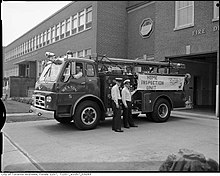
As part of the city's 2013 Budget plans, the City of Toronto demanded a 10% cut by all city departments. TFS, under then Fire Chief James Sales, recommended vehicle reductions at several stations (Stations 213, 215, 324 and 413) and one station to close (Station 424) to meet the 10% reduction target.[5] As well the cuts will lead to fewer firefighters on staff.[5]
In 2014, four pumpers (P213, P215, P413, P424) were taken out of service and Station 424 was shut down.
In 2017, under Fire Chief Matthew Pegg, the TFS Transformation Plan was developed and introduced, which included a comprehensive Inclusion Plan. An update on the status of the numerous initiatives that are included in this plan was provided as part of the 2018 budget process.[6]
In 2018, 10 additional staff were added to support the creation of a permanent Toronto Community Housing Fire Safety Task Force.[7] Also in 2018, one additional crew of 21 Operations Firefighters was approved to support the opening of the new Downsview fire station.[8][9]
Preceding fire services
[edit]Fire companies
[edit]- 1st Engine 1826 at Church Street and Newgate Street (Adelaide Street East), renumbered as Station 5 in 1861 and closed in 1874
- Independent Fire Company Engine House No. 2
- York Fire Company 1826 at Fireman's Hall (Church Street and Newgate Street)
- Hook and Ladder Fire Company 1831
- Fireman's Hall 1839 at Bay Street 1839; closed 1841
- Station No. 1 1841; closed 1924
- 4th Engine House at St. Patrick Market on Queen Street West 1842, closed 1861
- Hose Company No. 2 at Berkeley Street 1849; closed 1859
- 7th Engine Company at Elizabeth Street 1857; closed 1859
- Station No 2 at 163 Portland 1871; closed 1968
- Station No 3 at 488 Yonge Street 1871; closed 1926
- Station No 5 at Court Street 1874; closed 1886
- Station No 6 at 315 Queen Street West 1876; closed 1936
Fire departments
[edit]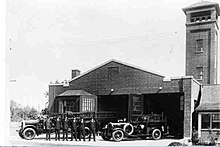
Organization
[edit]
The fire chief (C1), as well as the 4 commanding deputy chiefs,(C2, C3, C4, C5), are all based at 4330 Dufferin Street – the central headquarters for both Toronto Fire and Toronto Paramedic Services. There are four division commanders (C6, C7, C8, C9). Each division commander is based in their respective commands – north, east, south and west.
Alan F. Speed became the first fire chief of the amalgamated Toronto Fire Services in November 1997. He served in that post until his retirement in April 2003.
Following Speed's retirement, William (Bill) Stewart was appointed fire chief on May 1, 2003, and served until his retirement on April 30, 2012.
Jim Sales worked as a political bureaucrat in the Town of Markham and as general manager with the City of Barrie prior to his appointment as Toronto fire chief in 2012.[13] Sales was fire chief in Markham from 2000 to 2001 and in Edmonton from 1988 to 2000.[14]
Matthew Pegg was appointed as interim fire chief in May 2016, following Sales' departure.[15] Pegg became permanent chief in April 2017. Pegg served as deputy fire chief of Administration prior to being appointed fire chief.
Pegg retired October 4, 2024 and will be replaced on interim by Deputy Chief Larry Cocco.[16]
Previous chiefs
[edit]With the exception of Sales, Toronto Fire Services and Toronto Fire Department chiefs have been promoted within the department's ranks. Peter Ferguson was deputy chief of the North York Fire Department before becoming fire chief of the Toronto Fire Department
- Bernard (Ben) Bonser: 1977–1988[citation needed], Toronto Fire Department
- Walter Shanahan: 1988–1995, Toronto Fire Department
- Peter L Ferguson: 1995–1997,Toronto Fire Department
- Alan F. Speed: 1997–2003
- William A. Stewart: 2003–2012
- Jim W. Sales: 2012–2016
Rank structure
[edit]| Rank | Fire chief | Deputy fire chief | Division commander | Platoon chief | District chief | Captain | First class firefighter | Second class firefighter | Third class firefighter | Probationary firefighter |
|---|---|---|---|---|---|---|---|---|---|---|
| Insignia |  |  |  |  |  |  | No insignia | No insignia | No insignia | No insignia |
| Helmet colour | White | White | White | White | White | Red | Black | Black | Black | Black |
| Description | General manager | Second in command of TFS. Each deputy is responsible for a specific portfolio. | Responsible for all four shifts within one of the geographic divisions (north, east, south, or west) of the city. Responsible for a city-wide division (communications, investigations, mechanical, data analysis, etc.). | Responsible for all fire stations within all districts of a command for one shift (north, east, south, or west) | Responsible for all fire stations within a district (e.g. 11 District or 42 District) | In charge of one fire truck and crew | ||||
| Notes | "Chief" marked on the back of his or her bunker jacket | "Deputy Chief" marked on the back of their bunker jacket | "Division Commander" marked on the back of their bunker jacket | "Platoon Chief" marked on the back of their bunker jacket | "District Chief" marked on the back of their bunker jacket | "Probationary" marked in red on the front of their helmet |
Communications
[edit]Structure/building fires
[edit]| Alarm type | Alarm level | Units assigned |
|---|---|---|
| Structure fire | 1st alarm assignment | 1 squad truck/rescue truck, 3 pumpers/rescue trucks, 1 aerial truck/tower truck, 1 district chief unit, high rise unit (if the fire is in a high-rise building in south command) |
| Working fire | 1st alarm assignment, upgrade | 1 rescue truck (RIT), 1 aerial truck/tower truck, 1 squad/rescue truck, 1 platoon chief unit, 1 air & light unit |
| 2nd Alarm fire | 2nd alarm assignment, upgrade | 1 rescue truck (RIT), 3 pumper trucks/rescue trucks, 1 aerial truck/tower truck, 1 squad truck, 1 district chief unit, 1 platoon chief unit, 1 hazmat unit, 1 air & light unit, 1 command unit |
| 3rd Alarm fire | 3rd alarm assignment, upgrade | 3 pumper trucks/rescue trucks, 1 aerial truck/tower truck, 1 district chief unit, 1 tower truck, 1 tower support unit |
| 4th Alarm fire | 4th alarm assignment, upgrade | 3 pumper trucks/rescue trucks, 1 aerial truck/tower truck, 1 district chief unit, 1 air & lighting unit, 1 platoon chief unit (comms) |
| 5th Alarm fire | 5th alarm assignment, upgrade | 3 pumper trucks/rescue trucks, 1 aerial truck/tower truck, 1 district chief unit |
| 6th Alarm fire | 6th alarm assignment, upgrade | 3 pumper trucks/rescue trucks, 1 aerial truck/tower truck, 1 district chief unit |
Operations
[edit]Equipment
[edit]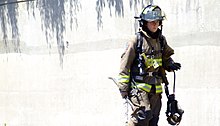
- Innotex – current bunker gear
- Cairns 660C Metro composite fire helmet – current fire helmet (as of June 2018)
- Drager UCF 7000 thermal imaging camera
- Globe Supreme 14 fire boot
- MSA G1 self-contained breathing aparatus
Fire apparatus
[edit]Toronto Fire Department began using motorized vehicles after 1911. The first motorized pumper was placed in the College St station on October 18, 1911. Before that, the TFD and previous fire companies used horse drawn engines and ladders. Prior to the 1970s, the TFD had open air vehicles (driver cab not enclosed and mostly aerial trucks), but since then both the TFD and TFS use fully enclosed cab vehicles. Prior to the 1950s, TFD used tiller-ladder trucks and since have reverted to smaller aerial units that can operate in narrow streets in Toronto.
The TFS inherited all the vehicles of the fire departments prior to amalgamation. The current strength of TFS consists of 179 vehicles. Since amalgamation, apparatus assignments consist of an alpha-numeric callsign. The alphabetic prefix identifies the type of apparatus. The following three numerical digits identify the station the apparatus is located in. The first digit identifies the division (Command) that the station is in (1-north, 2-East, 3-South, 4-West). The second digit identifies the District within the Command that the station is in. The last digit identifies the station within the District within the Command that the apparatus is assigned to.
A list of types of vehicles used by the TFS: (prefix letter in brackets with "xxx" as the station placeholders) is listed below:
- Frontline apparatus (staffed)
- Pumper companies (Pxxx) – Pumper companies operate standard pumper trucks. Pumper trucks are equipped with firefighting gear as well as basic rescue tools and other equipment
- Rescue (Rxxx) – Rescue Units operate a rescue pumper truck. Rescue units are equipped with firefighting gear as well as a variety of rescue tools and equipment. This includes the jaws of life hydraulic rescue tool systems (Spreaders,Cutters,Rams,Combi Tooks,Etc),Air Bags,Air,Electric and Battery Operated Power Tools,Rescue Saws,Generators,Rope Rescue Equipment,Emergency Medical Services Equipment and other specialized tools and equipment.
- Aerial (Axxx) – aerials operate straight aerial ladder (stick); lengths range from 23 to 32 metres (75 to 105 feet). This unit is configured as a quint (pump/tank). This unit carries specialized firefighting and rescue tools.
- Ladder (Lxxx) – Ladder companies operate straight aerial ladder (stick); lengths range from 30 to 32 metres (100 to 105 feet). It is configured as a truck (no pump/no tank). It carries specialized tools and equipment for all kinds of situations.
- Tower (Txxx) – Tower companies operate aerial platforms with articulating boom ladder. Two units only, with 1 found in South Command and 1 in North Command; length 35 metres (114 feet)
- Platform (PLxxx) – This unit operates an aerial ladder with attached platform. One unit only, found in West Command; length 30 metres (100 feet)
- Squad (Sxxx) – Squad companies operate heavy rescue units. These units are equipped with various types of specialized technical rescue equipment and tools. This includes the jaws of life hydraulic rescue tool systems (spreaders, cutters, combi tools, rams, etc),specialized rescue saws, air bags, air, electric and battery powered demolition drills, rotary hammers, reciprocating and circular saws, rope rescue equipment, hazardous materials response equipment, emergency medical services equipment and other types of specialized tools and equipment. Five units total, with two located in South Command and one each in of North, East, and West Commands.
- Haz-mat unit (HZxxx) – Hazardous materials trucks operate specialized trucks containing equipment that deals with hazardous materials/dangerous goods incidents. Hazardous materials personal protective equipment, non sparking tools, generators and other specialized tools and equipment are carried on the hazardous materials units. Two units only, one in each of North and South Commands.
- High rise unit (HRxxx) – Specialized rescue trucks containing equipment for high-rise incidents. Two units only, one in each of North and South Commands.
- Air/light unit (LAxxx) – These units carry electric items and resources for replenishing the self contained breathing apparatus that the firefighters use on fire incidents. 1 in each command (LA111, LA231, LA325, LA421)
- Chief units and command vehicles
- Fire chief / deputy chief (Cx) – These personnel are senior exempt rank members of the department
- Division commander (Cx) – There are four geographical divisions in the toronto fire services. 1 division commander unit is found in each command (C6, C7, C8, C9)
- Division chief (DVC) – There is 1 for communications, mechanical, investigations, prevention, finance and data analytics, etc.
- Platoon chief (PCX0) – Platoon chiefs are in charge of commanding each platoon of firefighters. There is 1 platoon chief unit in each command (C10, C20, C30, C40)
- District chief (DCxx) district chiefs are in charge of each district
- Command unit (CMDxx) – These vehicles are used as mobile command and control centres for fire personnel but they can also be used by police and emergency medical services personnel or other members as needed. Two units only, one in each of North and South Commands.
- Support apparatus (cross-staffed)
- Hazmat support unit (HSxxx) – Unmanned equipment vehicle
- Decontamination unit (DExxx)
- Water tanker (WTxxx) – 1 only, in East Command
- Rapid attack vehicle – 1 only, on Toronto Islands
- All-terrain vehicle (ATVx) – Used at special events, such as the Canadian National Exhibition
- Mini pumper (MPxxx)
- Multi-purpose vehicle (MPVxxx)
- Fireboat (FBxxx) – 2 units, both stationed in toronto harbour
- Trench rescue support truck (TRSxxx) – 1 only, in East Command
- High capacity foam pumper (FPxxx) 1 only, in North Command
- Mechanical response unit (MRUxxx)
- Miscellaneous apparatus
- Training pumper (TRPx) – Used by professional development and training
- Spare vehicles (X5xxx) – Backup apparatus used to temporarily replace frontline apparatus
- Fire investigator (FIx)
Fire boats
[edit]The Toronto Fire Department and successor Toronto Fire Services has operated fire boats since 1923. Fireboat Charles A. Reed was the first fireboat operated by the service; it was a wood-hull boat that entered service in 1923 and remained in use until 1964.[17]

The service presently has two fireboats in service. Fireboat William Lyon Mackenzie entered service in 1964, replacing Charles A. Reed. Fireboat William Lyon Mackenzie serves as the department's main fireboat and icebreaker. In 2006, the Toronto Fire Services acquired Fireboat Sora, a light utility boat built in 1982 for the Canadian Coast Guard. The Sora was retired from TFS on October 31, 2015, replaced by Fireboat William Thornton. Fireboat William Thornton is a type 400 cutter, built in 1982 for the Canadian Coast Guard, and was acquired by the Toronto Fire Service in 2015.
Miscellaneous units
[edit]While not part of the fleet, Box 12 (Box 12 Association) and Support 7 (Greater Toronto Multiple Alarm Association) are canteen trucks run by volunteers and are present at large emergencies to provide food and beverages for Toronto firefighters.
Formed in 1949, the Box 12 Association is Toronto's oldest fire canteen unit and serves firefighters in the west end and the downtown core. The unit is named after alarm box #12, which was pulled to trigger the response to the Great Toronto Fire of 1904. This canteen has served in a number of high-profile multiple alarm fires in recent history, including the Badminton and Racquet Club of Toronto six-alarm fire in 2017. The Box 12 Association celebrated 70 years of continuous volunteer service in 2018, with Mayor John Tory in attendance. Each year, an award named after this canteen is presented by the Toronto Professional Fire Fighters Association to a fire service member for voluntarism.
Formed in 1975, the GTMAA vehicle is painted with TFD scheme, but not the logo (using the GTMAA patch instead).
In addition, there are various hazardous materials support trucks and a trench rescue support truck that respond to specialized calls. These trucks are unmanned and are only used by trained personnel when a specialized call is dispatched. TFS also has a fleet of various mechanical support trucks. Smaller compact cars bearing the TFS colours and logo are driven by fire prevention officers and other commanding officers.
Toronto Fire will also acquire use of a long-range acoustic device. It was one of three purchased by the Toronto Police Service for use during the G20 summit in 2010 (1 for marine unit, 2 for public safety unit).[18]
Toronto Fire Services operates and manages both the heavy urban search and rescue (HUSAR) team and the chemical, biological, radiological, nuclear and explosives (CBRNE) response team on behalf of the City of Toronto and under contract with the Province of Ontario for provincial deployment as required as CAN-TF3.
Prior to amalgamation, the Scarborough Fire Department had their fleet painted yellow. In the years following amalgamation, the markings on the fire trucks were a patchwork of the various schemes used by the former boroughs. All had "Toronto" decaled or painted where the former borough's name used to be and the new Toronto Fire crest was added with the new numbering scheme. Over the past 19 years since amalgamation, the majority of the older vehicles have either been retired or repainted to match the new scheme: fire engine red with yellow reflective trim and markings.
Fire stations
[edit]The Toronto Fire Services currently operates out of 83 fire stations throughout the city, organized into 15 districts. A 16th district (District 12) was disbanded in 2013. Its 4 stations were absorbed into the surrounding districts. Each district is part of one of four geographical divisions of command. There are 4 command areas: north, east, south and west. With the exception of North Division, the other geographic divisions are divided into four districts. Several companies have been disbanded or reassigned over the years.[19][20]
North Command
[edit]The North Command's office (Command 1) is located at Fire Station 114. There are 21 stations in the North Command
| Station # | District # | Neighbourhood | Pumper company | Rescue company | Aerial company or tower company | Platoon chief units or district chief units | Miscellaneous units | Address/suburb | Build year |
|---|---|---|---|---|---|---|---|---|---|
| 111 | 11 | Bayview Heights | Pumper 111 | Air/Light Unit 111 | 3300 Bayview Avenue, North York | 1979 | |||
| 112 | 11 | Branson | Pumper 112[21] | Rescue 5112 | 5700 Bathurst Street, North York | 1978 | |||
| 113 | 11 | Don Valley Village | Pumper 113 | Aerial 113 | 700 Seneca Hill Drive, North York | 1969 | |||
| 114 | 11 | Willowdale | Pumper 114 | Tower 114 | Platoon chief Unit 10 | High Rise 114 | 12 Canterbury Place, North York | 1989 | |
| 115 | 11 | Parkway Forest | Rescue 115 | 115 Parkway Forest Drive, North York | 1983 | ||||
| 116 | 11 | Bayview Village | Pumper 116 | District chief Unit 11 | Rehab 1 Command 10 | 255 Esther Shiner Boulevard, North York | 2007 | ||
| 121 | 11 | Hoggs Hollow | Pumper 121 | Foam Pumper 121, Pumper 5121 | 10 William Carson Crescent, North York | 1988 | |||
| 122 | 11 | York Mills | Rescue 122 | Pumper 5122 | 2545 Bayview Avenue, North York | 1959 | |||
| 123 | 13 | Don Mills | Pumper 123 | 143 Bond Avenue, North York | 1956 | ||||
| 125 | 13 | Flemingdon Park | Pumper 125 | Aerial 125 | 1109 Leslie Street, North York | 1985 | |||
| 131 | 13 | Yonge and Lawrence | Pumper 131 | 3135 Yonge Street | 1931 | ||||
| 132 | 13 | Lawrence Manor | Pumper 132 | District chief Unit 13 | 476 Lawrence Avenue West, North York | 1999 | |||
| 133 | 13 | Amesbury | Rescue 133 | Aerial 133 | 1507 Lawrence Avenue West, North York | 1962 | |||
| 134 | 13 | Yonge and Eglinton | Pumper 134[22] | 16 Montgomery Avenue | 1916 | ||||
| 135 | 13 | Forest Hill | Pumper 135 | Aerial 135 | 325 Chaplin Crescent | 2016 | |||
| 141 | 14 | University Heights | Pumper 141 | District chief unit 14 | Pumper 5141 Rescue 5141 | 4100 Keele Street, North York | 2011 | ||
| 142 | 14 | Jane and Finch | Pumper 142 | Aerial 142 | 2753 Jane Street, North York | 1982 | |||
| 143 | 14 | Clanton Park | Pumper 143 | Squad 143 | 1009 Sheppard Avenue West, North York | 1972 | |||
| 144 | 14 | Downsview | Pumper 144 | Fire Investigations | 2945 Keele Street, North York | 2022 | |||
| 145 | 14 | Ancaster | Pumper 145 | Haz-Mat Unit 145 Haz-Mat Support Unit 145 | 20 Beffort Road, North York | 1989 | |||
| 146 | 14 | Downsview | Pumper 146 | 2220 Jane Street, North York | 1956 |
East Command
[edit]The East Command's office (Command 2) is located at Fire Station 221. There are 22 stations in the East Command.
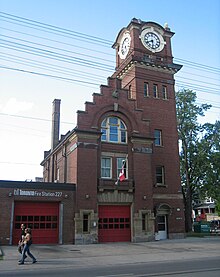
| Station # | District # | Neighbourhood | Pumper company | Rescue company | Aerial company | District chief Units or platoon chief units | Miscellaneous units | Address/Suburb | Build year |
|---|---|---|---|---|---|---|---|---|---|
| 211 | 21 | Armdale | Pumper 211 | Tanker 211 | 900 Tapscott Road, Scarborough | 1982 | |||
| 212 | 21 | Dean Park | Pumper 212 | District chief Unit 21 | Mini Pumper 212 | 8500 Sheppard Avenue East, Scarborough | 2003 | ||
| 213 | 21 | Malvern | Pumper 213[23] | Aerial 213 | 7 Lapsley Road, Scarborough | 1974 | |||
| 214 | 21 | Highland Creek | Rescue 214 | 745 Meadowvale Road, Scarborough | 1982 | ||||
| 215 | 21 | Port Union | Aerial 215 | 5318 Lawrence Avenue East, Scarborough | 1974 | ||||
| 221 | 22 | Scarborough Junction | Pumper 221 | Aerial 221 | 2575 Eglinton Avenue East, Scarborough | 2014 | |||
| 222 | 22 | Golden Mile | Pumper 222 | 755 Warden Avenue, Scarborough | 1961 | ||||
| 223 | 22 | Cliffcrest | Rescue 223[24] | Support Unit 7 | 116 Dorset Road, Scarborough | 1953 | |||
| 224 | 22 | Woodbine Heights | Pumper 224[25] | 1313 Woodbine Avenue, East York | 1952 | ||||
| 225 | 22 | Birch Cliff | Pumper 225[26] | District chief Unit 22 | 3600 Danforth Avenue, Scarborough | 1998 | |||
| 226 | 22 | Upper Beaches | Pumper 226 | Ladder 226 | 87 Main Street | 1909 | |||
| 227 | 22 | The Beaches | Rescue 227[27] | Pumper 5227 | 1904 Queen Street East | 1905 | |||
| 231 | 23 | Woburn | Pumper 231[28] | Aerial 231 | Platoon chief Unit 20 District chief Unit 23 | Air/Light Unit 231 | 740 Markham Road, Scarborough | 1960 | |
| 232 | 23 | Dorset Park | Pumper 232 | Squad 232 | 1550 Midland Avenue, Scarborough | 1963 | |||
| 233 | 23 | Parkwoods | Pumper 233 | Aerial 233 | Antique (x2) | 59 Curlew Drive, North York | 1995 | ||
| 234 | 23 | West Hill | Pumper 234 | Decon Unit 234 | 40 Coronation Drive, Scarborough | 1968 | |||
| 235 | 23 | Bermondsey | Rescue 235 | Technical Rescue Support Unit 235 | 200 Bermondsey Road, North York | 1960 | |||
| 241 | 24 | L'Amoreaux | Rescue 241 | Pumper 5241 | 3325 Warden Avenue, Scarborough | 1980 | |||
| 242 | 24 | Brimley Forest | Pumper 242 | Aerial 242[29] | 2733 Brimley Road, Scarborough | 1975 | |||
| 243 | 24 | Agincourt | Rescue 243 | 4560 Sheppard Avenue East, Scarborough | 1972/1985 | ||||
| 244 | 24 | Leacock | Pumper 244 | District chief Unit 24 | 2340 Birchmount Road, Scarborough | 1971 | |||
| 245 | 24 | Wexford | Pumper 245 | Pumper 5245 | 1600 Birchmount Road, Scarborough | 1956 |
South Command
[edit]The South Command's office (Command 3) is located at Fire Station 332. There are 22 stations in South Command.
| Station # | District # | Neighbourhood | Pumper company | Rescue company | Aerial company or tower company | District chief Units or platoon chief units | Miscellaneous units | Address/suburb | Build year |
|---|---|---|---|---|---|---|---|---|---|
| 311 | 31 | Yonge and St Clair | Pumper 311 | 20 Balmoral Avenue | 1911 | ||||
| 312 | 31 | Yorkville | Pumper 312 | Ladder 312 | District chief Unit 31 | 34 Yorkville Street | 1876/1973 | ||
| 313 | 31 | St. James Town | Pumper 313 | Squad 313 | 411 Bloor Street East | 1967 | |||
| 314 | 31 | Church and Wellesley | Pumper 314 | 12 Grosvenor Street | 1926 | ||||
| 315 | 31 | Kensington Market | Pumper 315 | Ladder 315 | Parade unit | 132 Bellevue Avenue | 1878/1973 | ||
| 321 | 32 | Leaside | Rescue 321 | 231 McRae Drive | 1946 | ||||
| 322 | 32 | Pape Village | Pumper 322 | Aerial 322 | 256 Cosburn Avenue, East York | 1994 | |||
| 323 | 32 | Greektown | Pumper 323 | Haz-Mat Unit 323 | 153 Chatham Avenue, East York | 1963 | |||
| 324 | 32 | Riverdale | Pumper 324 | District chief Unit 32 | 840 Gerrard Street East | 1932 | |||
| 325 | 32 | Regent Park | Rescue 325 | Ladder 325 | Air/Light 325 | 475 Dundas Street East | 1954 | ||
| 326 | 32 | Leslieville | Pumper 326 | Haz-Mat Support 326 | 30 Knox Avenue | 1980 | |||
| 331 | 33 | Trinity Bellwoods | Pumper 331 | Ladder 331 | Squad 331 | 33 Claremont Street | 1968 | ||
| 332 | 33 | Entertainment District | Pumper 332 | Platoon chief Unit 30 District chief Unit 33 | Command 30 High Rise 332 Personnel Transport 1 | 260 Adelaide Street West | 1971 | ||
| 333 | 33 | St Lawrence | Pumper 333 | Tower 333 | Tower 1 | 207 Front Street East | 1970 | ||
| 334 | 33 | Harbourfront | Pumper 334 | Fireboat (x3) | 339 Queens Quay West | 2000 | |||
| 335 | 33 | Ward's Island | Pumper 335 Pumper 335B | Rapid Attack Vehicle 335 | 235 Cibola Avenue | 1992 | |||
| 341 | 34 | Oakwood Village | Rescue 341 | Aerial 341 | Multi-Purpose Vehicle 341 Car 5341 | 555 Oakwood Avenue, York | 1968 | ||
| 342 | 34 | Corso Italia | Pumper 342 | 106 Ascot Avenue | 1912 | ||||
| 343 | 34 | Hillcrest Village | Pumper 343 | 65 Hendrick Avenue | 1915 | ||||
| 344 | 34 | The Annex | Pumper 344 | Pumper 5344 | 240 Howland Avenue | 1911 | |||
| 345 | 34 | Davenport | Rescue 345 | District chief Unit 34 | Box 12 | 1285 Dufferin Street | 1963 | ||
| 346 | 34 | CNE Grounds | Pumper 346 | 90 Quebec Street | 1912 |
West Command
[edit]The West Command's office (Command 4) is located at Fire Station 442. Fire Station 424 at 462 Runnymede Road closed permanently in 2014. There are 19 stations in West Command.
| Station # | District # | Neighbourhood | Pumper company | Rescue company | Aerial company or platform company | District chief Units or platoon chief units | Miscellaneous units | Address/suburb | Build year |
|---|---|---|---|---|---|---|---|---|---|
| 411 | 41 | Humber Summit | Rescue 411 | Aerial 411 | 75 Toryork Drive, North York | 1997 | |||
| 412 | 41 | Clairville | Rescue 412 | 267 Humberline Drive, Etobicoke | 1975 | ||||
| 413 | 41 | Smithfield | Rescue 413 | 1549 Albion Road, Etobicoke | 1970 | ||||
| 415 | 41 | Rexdale | Pumper 415 | Aerial 415 | District chief Unit 41 | 2120 Kipling Avenue, Etobicoke | 1955 | ||
| 421 | 42 | Mount Dennis | Rescue 421 | Aerial 421 | Air/Light Unit 421 | 6 Lambton Avenue, York | 1956 | ||
| 422 | 42 | Lambton | Pumper 422 | Parade unit | 590 Jane Street, York | 1965 | |||
| 423 | 42 | The Junction | Rescue 423 | Aerial 423 | District chief Unit 42 | 358 Keele Street | 1954 | ||
| 425 | 42 | Swansea | Rescue 425 | 83 Deforest Road | 1930 | ||||
| 426 | 42 | Parkdale | Pumper 426 | Ladder 426 | 140 Lansdowne Avenue | 1972 | |||
| 431 | 43 | Sunnylea | Pumper 431 | 308 Prince Edward Drive South, Etobicoke | 1959 | ||||
| 432 | 43 | Islington – City Centre West | Pumper 432 | Platform 432 | 155 The East Mall, Etobicoke | 1980 | |||
| 433 | 43 | The Queensway | Pumper 433 | Aerial 433 | 615 Royal York Road, Etobicoke | 1953/2007 | |||
| 434 | 43 | Alderwood | Rescue 434 | 3 Lunness Road, Etobicoke | 1957 | ||||
| 435 | 43 | New Toronto | Pumper 435 | District chief Unit 43 | 130 Eighth Street, Etobicoke | 1930 | |||
| 441 | 44 | Airport Strip | Rescue 441 | Aerial 441 | 947 Martin Grove Road, Etobicoke | 1963 | |||
| 442 | 44 | Weston | Pumper 442 | 2015 Lawrence Avenue West, York | 1991 | ||||
| 443 | 44 | Princess Gardens | Pumper 443 | Rescue 5443 | 1724 Islington Avenue, Etobicoke | 1958 | |||
| 444 | 44 | Centennial Park | Rescue 444 | 666 Renforth Drive, Etobicoke | 1959 | ||||
| 445 | 44 | Islington Village | Pumper 445 | Platoon chief Unit 40 District chief Unit 44 | Squad 445 | 280 Burnhamthorpe Road, Etobicoke | 1960 |
See also
[edit]Other members of Toronto's Emergency Services structure include:
References
[edit]- ^ a b "Toronto Fire Services 2023 Annual Report" (PDF). City of Toronto. Retrieved November 3, 2024.
- ^ "Page Not Found". Archived from the original on 2017-03-01. Retrieved 2017-02-26.
{{cite web}}: Cite uses generic title (help) - ^ "Fire House c.1850. Black Creek Pioneer Village. Toronto, Canada". flickr. 22 August 2009. Archived from the original on 25 December 2021. Retrieved 13 January 2017.
- ^ a b "Fire Services – City of Toronto". Fire Services – City of Toronto. 26 September 2017. Archived from the original on 14 March 2023. Retrieved 14 March 2023.
- ^ a b "Closures report". CBC News. Archived from the original on 2012-12-08. Retrieved 2012-12-07.
- ^ "Documentsdate=2018" (PDF). www.toronto.ca. Archived (PDF) from the original on 2018-01-26. Retrieved 2018-05-24.
- ^ "Documents" (PDF). www.toronto.ca. 2018. Archived (PDF) from the original on 2018-05-25. Retrieved 2018-05-24.
- ^ Toronto, City of (1 December 2017). "Toronto Fire Services". toronto. Archived from the original on 25 May 2018. Retrieved 24 May 2018.
- ^ "Operating Budget Notes 2018, Toronto Fire Services" (PDF). Archived (PDF) from the original on 2018-01-26. Retrieved 2018-12-24.
- ^ "History". scarboroughfirefighters.org. Archived from the original on 2008-05-13. Retrieved May 3, 2014.
- ^ "North York F.D. Information". northyorkfire.org. Archived from the original on 2003-02-14. Retrieved May 3, 2014.
- ^ "New Toronto Fire Department". newtorontohistorical.com. Archived from the original on 2004-07-10. Retrieved May 3, 2014.
- ^ Doolittle, Robyn (July 12, 2012). "Toronto's new fire chief a top bureaucrat from Barrie". The Toronto Star. Archived from the original on July 17, 2012. Retrieved July 13, 2012.
- ^ "Press Release|Congratulations Jim Sales!". www.barrie.ca. July 13, 2012. Archived from the original on 2019-12-24. Retrieved 2019-12-24.
- ^ "Toronto Fire Chief Jim Sales departs from role – CityNews Toronto". CityNews. 7 October 2016. Archived from the original on 8 October 2016. Retrieved 7 October 2016.
- ^ https://www.oafc.on.ca/about/announcements/new-chief-announcements/toronto-fire-services-selects-interim-fire-chief#:~:text=Deputy%20Fire%20Chief%20Larry%20Cocco,stepping%20down%20the%20same%20day.
- ^ Discover & explore Toronto's waterfront, Mike Filey, pp34
- ^ Police Will Keep G20 Sound Cannons Archived 2012-01-26 at the Wayback Machine
- ^ "Fire Station Locations – Toronto Fire Services – Emergency Services | City of Toronto". toronto.ca. Archived from the original on August 31, 2013. Retrieved May 3, 2014.
- ^ "Toronto Fire Stations". Archived from the original on 2014-06-20.
- ^ "TFS Pics - Pumper 112". Retrieved 20 February 2024.
- ^ "TFS Pics - Pumper 134". Retrieved 20 February 2024.
- ^ "TFS Pics - Pumper 213". Retrieved 20 February 2024.
- ^ "TFS Pics - Rescue 223". Retrieved 20 February 2024.
- ^ "TFS Pics - Pumper 224". Retrieved 20 February 2024.
- ^ "TFS Pics - Pumper 225". Retrieved 20 February 2024.
- ^ "TFS Pics - Rescue 227". Retrieved 20 February 2024.
- ^ "TFS Pics - Pumper 231". Retrieved 20 February 2024.
- ^ "TFS Pics - Aerial 242". Retrieved 20 February 2024.
